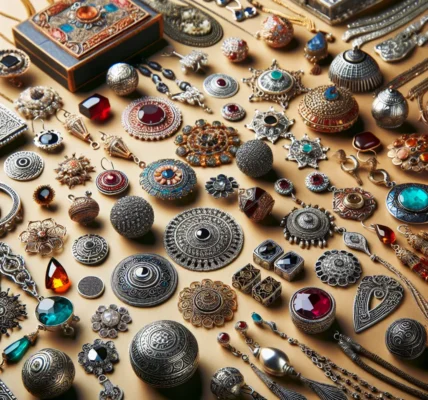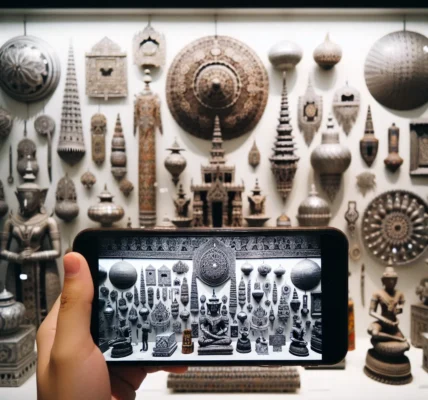Symbolism of Ornamental Art: Unveiling the Cultural Meanings
Ornaments have played a significant role in expressing cultural meanings and symbolism across different societies throughout history. The symbolic significance of ornamental art can be observed in various forms, including jewelry, clothing, and home decor. In many cultures, ornaments are not merely decorative items but carry deep symbolic meanings that reflect beliefs, traditions, and societal values.
In some societies, specific ornaments may signify social status, wealth, or religious affiliation. For example, the use of gold or precious gemstones in jewelry can symbolize prosperity and high social standing. Similarly, the presence of religious motifs in ornamental art can convey spiritual beliefs and traditions unique to a particular cultural group.
Moreover, ornaments often serve as a means of communication, conveying messages about the wearer’s identity, marital status, or affiliation with a certain community or group. In many African societies, colorful beaded necklaces and bracelets are used to communicate tribal affiliations and traditions, while in some Asian cultures, intricate patterns on clothing and accessories hold symbolic meanings tied to heritage and social roles.
Furthermore, ornaments are frequently utilized in rituals and ceremonies, serving as important elements in cultural practices and traditions. Whether it’s the adornment of ceremonial masks or the use of specific symbols in traditional garments, ornamental art plays a crucial role in preserving and transmitting cultural heritage from one generation to the next.
The study of the symbolism of ornamental art provides valuable insights into the diverse cultural expressions and traditions of different societies. By examining the meanings behind various ornaments, we gain a deeper understanding of the values, beliefs, and social structures that shape different cultural identities.
As societies continue to evolve, the significance of ornamental art remains a compelling area of study, offering a lens through which to explore the intricate tapestry of human cultural expression and symbolism.
By delving into the symbolic meanings of ornaments across different societies, we enrich our appreciation of the diversity and richness of global cultural heritage.
Evolution of Ornaments: Tracing Their Role in Diverse Societies
When examining the evolution of ornaments and their role in diverse societies, it becomes evident that these decorative objects have held significant cultural significance throughout history. From the ancient civilizations of Egypt and Mesopotamia to the indigenous cultures of the Americas and the traditional societies of Asia and Africa, ornaments have played a crucial role in expressing cultural identity, social status, and spiritual beliefs. The evolution of ornaments can be traced through the archaeological findings and historical records of various civilizations, providing valuable insights into the development of human societies and their aesthetic expressions.
In ancient Mesopotamia, for example, cylinder seals were intricately carved with symbolic imagery and served as both decorative ornaments and practical tools for sealing clay tablets. These seals not only conveyed the social status of their owners but also depicted religious narratives and mythological scenes, reflecting the spiritual beliefs of the society. Similarly, in Mesoamerica, the use of jade ornaments by the Olmec and Maya civilizations was deeply intertwined with religious rituals and symbolism, showcasing the spiritual significance of such adornments in these societies.
Furthermore, the evolution of ornaments in different societies can be observed in the materials and techniques used for their creation. From the intricate metalwork of Celtic jewelry to the ornate beadwork of indigenous tribes, ornaments have reflected the artistic craftsmanship and cultural traditions of diverse societies. The symbolism associated with specific ornaments, such as amulets for protection or wedding dowries for ceremonial purposes, further illustrates their role in expressing cultural values and beliefs.
In the modern era, the significance of ornaments continues to evolve, with contemporary artists and designers drawing inspiration from traditional ornamentation to create innovative and culturally relevant pieces. As globalization and cultural exchange influence the design and production of ornaments, there is a growing appreciation for the diversity of ornament styles and their multifaceted meanings in different societies.
Overall, the evolution of ornaments reveals the intricate interplay between art, culture, and society, highlighting the enduring significance of these decorative objects as expressions of human creativity and cultural identity.
Cultural Diversity in Ornamental Expressions
Ornaments have always held a significant place in the cultural expressions of societies around the world. The diversity in ornamental traditions reflects the rich tapestry of cultural practices and beliefs across different communities. From intricate beadwork to elaborate metalwork, ornaments serve as more than just decorative accessories—they embody the values, traditions, and identities of the people who create and wear them.
One striking aspect of the cultural diversity in ornamental expressions is the use of specific materials that hold symbolic meaning within a particular society. For example, in some African cultures, beads are intricately woven into jewelry and clothing, serving as a form of visual language that communicates social status, tribe affiliation, and even spiritual beliefs. In contrast, the use of precious metals such as gold and silver in ornaments in many Western societies symbolizes wealth, luxury, and sometimes, a symbol of love and commitment.
Furthermore, the designs and motifs found in ornaments often carry deep cultural significance. In South Asian cultures, intricate meenakari work on jewelry is not only a display of craftsmanship, but also a reflection of traditional beliefs and mythological narratives. Similarly, Native American tribes use intricate patterns and symbols in their beadwork to convey stories of their heritage and connection to the natural world.
Moreover, the rituals and ceremonies associated with ornamental traditions also vary widely across different societies, further illustrating the cultural diversity in the significance of ornaments. For instance, in some Southeast Asian societies, ornate jewelry and accessories are an integral part of traditional wedding ceremonies, symbolizing the union of two individuals and their families. On the other hand, Maasai communities in East Africa adorn themselves with vibrant beadwork during rites of passage, signifying the transition from one life stage to another.
In essence, the cultural significance of ornaments is a testament to the diversity of human expression and tradition. Each society’s ornamental practices offer a unique window into their cultural values, history, and worldview, highlighting the beauty of cultural diversity in the world of ornamentation.
Tradition and Modernity: The Intersection in Ornamentation Practices
When examining the cultural significance of ornaments in different societies, it becomes apparent that the intersection of tradition and modernity plays a crucial role in ornamentation practices. Throughout history, ornaments have held deep cultural, social, and religious significance, serving as a reflection of tradition and an expression of identity. However, in today’s globalized world, the dynamics of ornamentation have evolved to incorporate modern elements while still preserving traditional values.
In many traditional societies, ornaments are deeply rooted in rituals, ceremonies, and rites of passage, symbolizing cultural heritage and ancestry. The intricate designs and materials used in ornaments often carry specific meanings and hold significant historical relevance. With the advent of modernity, traditional ornamentation practices have adapted to incorporate contemporary styles and materials, reflecting the changing social and cultural landscape.
Furthermore, the intersection of tradition and modernity in ornamentation practices can be seen in the evolving craftsmanship and production methods. While traditional techniques are revered for their historical significance, modern technology has allowed for new methods of ornamentation, leading to innovative and dynamic designs that blend tradition with contemporary aesthetics.
Despite the influence of modernity, many societies continue to place great emphasis on preserving and promoting traditional ornamentation practices as a means of safeguarding their cultural heritage. This intersection of tradition and modernity in ornamentation serves as a testament to the adaptability of cultural practices in the face of globalization and technological advancement, illustrating the enduring significance of ornaments in shaping and expressing cultural identity.




